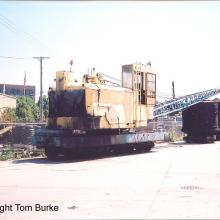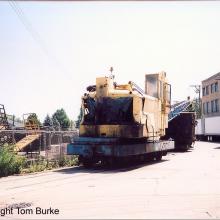861 Hits for February 2013
Albums (0) & Images (861)
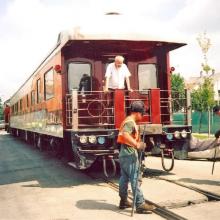
tb_ctr_coach_08232008_4
Shoving south the train pauses to let the CTR crew push the switch points into place. The hidden throw beneath the metal plate in the street must not be working after being out of service since early 2007 when Peerless shut down. There was evidence of the train pushing asphalt out of the flangeways on Lakewood where spot paving of potholes had taken place.tb_ctr_coach_08232008_4
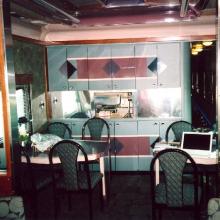
tb_ctr_coach_08232008_5
View of the interior of the coach used by Iowa Pacific in their tour of rare trackage for customers. It definitely attracted a lot of questions, stares, and picture taking by neighbors and passersby.tb_ctr_coach_08232008_5
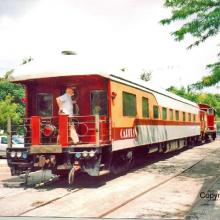
tb_ctr_coach_08232008_7
The train only made it as far south as the parking lot north of Altgeld due to dozens of cars being parked across the tracks outside the Lakeshore Health Club. Plans were made to come back late at night to resume the journey back.tb_ctr_coach_08232008_7
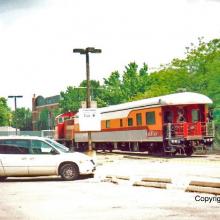
tb_ctr_coach_08232008_8
Another angle, this time looking northeast across the parking lot. People enjoyed posing for pictures next to the elegant coach.tb_ctr_coach_08232008_8
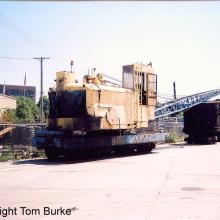
tb_deering.finkl_072006_01
On a hot late Saturday morning in July 2006 the western stub end of the Deering Line saw some train action for the first time in many years. Finkl Steel parked their in-house crane and specialized cars outside of the gates and right on Dominick Street near McLean Avenue, presenting a rare photo-op.tb_deering.finkl_072006_01
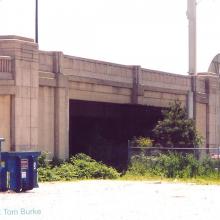
tb_deeringashland_0703_01
This July, 2003, view looks southwest at the Ashland Avenue bridge where it crossed over both the Milwaukee Road's Deering Line and the North Branch of the Chicago River. The dark opening is where freight trains once traveled to and from the many industries in the Deering Industrial District. By the early 1980s the tracks were removed in this section. The picture was taken from the parking lot of the Wendy's restaurant with a zoom lens. There is no public access to the underpass as the land is fenced off.tb_deeringashland_0703_01
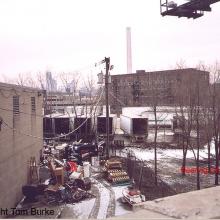
tb_deeringashland_12282004_01
This perspective shot looks southeast from the Ashland Avenue bridge across the former Milwaukee Road Deering Line with the Gutmann Tannery building in the background. The two tracks visible on the right in this picture represent the longest stretch of isolated Deering Line rails left intact. In 2004 brush and debris were cleared from the right of way between the Salvation Army store and the Chicago River, exposing once again these tracks. The track on the right was a spur that went into the Lakin & Sons tire yard while the track on the left was the main line which continued through the gate and the Lakin tire yard, eventually crossing Webster St. by Gutmann Tannery. Gutmann Tannery was served by the Milwaukee Road's Deering Line and is still in operation as of 2004 despite gentrification of the area.tb_deeringashland_12282004_01

tb_deeringashland_12282004_02
From the opposite side of the Art Deco Ashland Avenue bridge we're looking north towards Medill St. The underpass was used by the Milwaukee Raad's Deering Line to reach customers all the way up towards Diversey Boulevard at one time. The Wendy's restaurant sits where a pair of team tracks once were. The isolated segment of Deering Line tracks continues under the bridge but stop abruptly at the gate. The City of Chicago purchased the land to the left or west from the Milwaukee Road in the early 1980s when the Deering Line was cut back to the bridge.tb_deeringashland_12282004_02
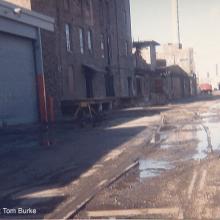
tb_deeringdominick_011990_01
A different view of the Deering Line on Dominick St. in January of 1990, looking north, just prior to repaving which will remove these tracks. On the left is a spur with a bumping post while farther down to the left is the Gutmann Tannery. Gentrification is already in progress as noted by the parking garage in the distance on the right for the new Webster Place shopping center and movie theater complex.tb_deeringdominick_011990_01
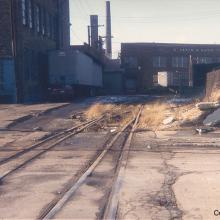
tb_deeringfinkltailtrack_011990_01
This view from January of 1990 looks west down the Deering Line from where it crossed Southport Avenue. On the left is the main Deering track which will soon veer to the north and travel down the middle of Dominick Ave. to reach other industries. The track to the right is the tail track for backup moves onto Finkl Steel's spurs. As of 2004 this section of Southport Ave. is vacated by the City of Chicago and now part of Finkl Steel's complex, with no public access.tb_deeringfinkltailtrack_011990_01
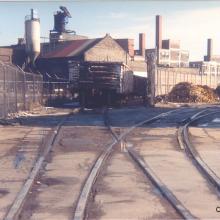
tb_deeringfinkltailtrack_011990_02
We're looking east from the same spot as the first photo at the Deering Line where it crossed Southport Ave. On the left is the main Deering track and the spurs into Finkl Steel's plant on the right. About a block farther east on the main track the Deering Line will rejoin the main Soo Line track once known as the Milwaukee Road's C&E line in the middle of Kingsbury St.Several empty gondolas sit on the Deering track awaiting pickup from the Soo Line. By the time of this photo in 1990 Finkl Steel was the only customer left on the Deering Line so it really didn't matter if cars were left on the main track. Finkl Steel still uses a self-propelled crane on rails to move cars inside the plant once they are dropped off by CP Rail which absorbed subsidiary Soo Line.
tb_deeringfinkltailtrack_011990_02
Several empty gondolas sit on the Deering track awaiting pickup from the Soo Line. By the time of this photo in 1990 Finkl Steel was the only customer left on the Deering Line so it really didn't matter if cars were left on the main track. Finkl Steel still uses a self-propelled crane on rails to move cars inside the plant once they are dropped off by CP Rail which absorbed subsidiary Soo Line.
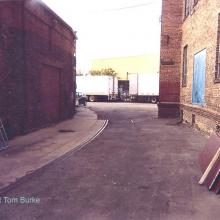
tb_deeringfinkl_01
Durng an August, 2003, concert (Echo & The Bunnymen) hosted by Finkl Steel and WXRT, I was able to get this photo of a segment of a Deering Line spur which meandered into the present-day Finkl Steel campus to serve several industries at one time. Note the girder rail used on the curves. In the late 1980s the City of Chicago vacated the public streets around Armitage and Southport in the area and turned it over to Finkl Steel. The only time the public has access to this part of the Finkl campus is during concerts in the summer.This photo also shows how the brick industrial buildings were at one time built around the curves and contours of the rail lines which served them. This pattern was typical on the Milwaukee Road's North Side operations until widescale deindustrialization and gentrification changed the landscape.
tb_deeringfinkl_01
This photo also shows how the brick industrial buildings were at one time built around the curves and contours of the rail lines which served them. This pattern was typical on the Milwaukee Road's North Side operations until widescale deindustrialization and gentrification changed the landscape.

